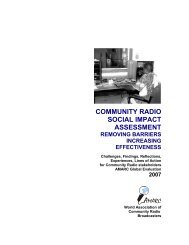Live News - A Survival Guide - International Federation of Journalists
Live News - A Survival Guide - International Federation of Journalists
Live News - A Survival Guide - International Federation of Journalists
- No tags were found...
You also want an ePaper? Increase the reach of your titles
YUMPU automatically turns print PDFs into web optimized ePapers that Google loves.
CHAPTER 5Emergency medical aidRemember a simple phrase to remind you what to do:Dr ABCD is for Danger – covered in points 1-4 above.Tip the head back so the jaw is atright angles to the ground to openthe airway. Photos: Rob Judges“If they talk back to you, their airwayis clear. If they are screaming,their airway is excellent. The one tobe concerned about is the quietone in the corner, who is not callingfor help.”Paul Brown, Medical Director,AKE trainingA Guedeal airway will help an unconsciouscasualty to breathe.r is for Responses: Talk to the casualty. Your two aims are to findout what they can tell you about their condition and to givereassurance. If the patient is conscious, ask them what hurts. Ifwhat they say does not match what you can see, there may behidden injuries. If they feel cold, and the outside temperature isnot cold, they may be losing blood. At all times reassure thepatient. Convince them that you know what you are doing, thatthey are going to be all right and that they will help by stayingawake and co-operating. In extreme cases, comfort and reassurancemay be the only things you can <strong>of</strong>fer. Do it anyway.Even if a casualty seems not to be responding, continue to givereassurance as you make your checks. A casualty may be semiconscious(with a limited response to a voice or to pain) orunconscious (no responses). Hearing is the last sense to go, andthey may still be aware <strong>of</strong> what you are saying.A is for Airway: Check that the airway is clear. Sweep a fingeraround the inside <strong>of</strong> the mouth and as far down the throat asyou can reach to remove any obstacles. Very noisy breathing maybe a sign that something is wrong with the airway — there couldbe a blockage or blood entering the airway. Unconscious casualtiesmay asphyxiate. Tip the head back so that the jaw line pointsupward at a right angle to the ground. The body has an automotivereaction to breathe and this should start. If the patient isunconscious or is having trouble breathing, insert a (number 3or 4) plastic Guedeal airway (see picture), with the curved tubegoing towards the windpipe. This will hold the tongue down andkeep the airway open. The patient cannot swallow the airway.You should practise this on your first aid course.B is for Breathing: If the airway is clear and the patient is still notbreathing, the heart may be in irregular beat or have stopped.Attempt cardio-pulmonary resuscitation (CPR). The normal number<strong>of</strong> breaths is around 16-18 a minute, but expect this to rise toaround 20, because the patient is in an excited state. Rapid shallowbreathing can be a sign that there is a puncture to the lung,74
















